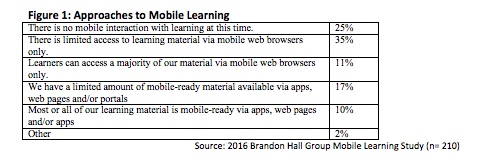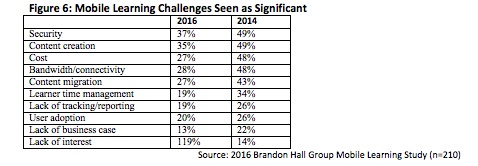
It has been nearly 10 years since the iPhone debuted, and in that time, smartphones have become culturally ubiquitous around the globe. Organizations have embraced the technology, using it to communicate with customers, deliver services, sell products, etc. Mobile devices have seemed perpetually poised to be the next technology breakthrough for learning. According to Brandon Hall Group’s most recent Mobile Learning Study, that wait continues.
In 2014, 27 percent of companies said that there was no mobile interaction with learning. In 2016, that number has dropped only slightly to 25 percent. In that same time we’ve moved from the iPhone 4 to the iPhone 6 and from Android KitKat to Marshmallow, yet the needle hasn’t really moved for mobile learning. The levels of sophistication around what companies are actually doing with mobile hasn’t really changed much either.

Nearly half of those companies that are using mobile delivery say access is limited and typically only via a mobile browser, while only 13 percent say they have an all-access, mobile friendly environment. This, too, hasn’t changed significantly since 2014.
Top 5 Research Findings
1. Mobile Is Part of the Learning Strategy
Although adoption seems to be stagnant as organizations figure out how best to leverage mobile devices, the vast majority of companies recognize they need a strategy to move forward. Nearly one-quarter (23 percent) of companies already have a mobile learning strategy in place, while 57 percent say they are working on it. Another 12 percent say that mobile is part of the overall learning and/or business strategy, but there is no standalone strategy.

Fewer than 9 percent of companies say they have no interest in a mobile learning strategy of any sort. So, despite the fact that nearly 25 percent of organizations are not engaging in mobile learning, strategies are being formulated and implemented to address the issue. Increasingly, companies no longer are thinking of mobile learning as a separate entity within learning, but rather as a piece of the overarching strategy. These are the companies that fall into the 12 percent “Other” category. Here are some of the ways these companies describe their mobile learning strategy (or lack thereof):
- It is part of a broader learning strategy.
- Mobile is part of our broader business strategy. Any course we can make mobile, we do.
- Mobile is part of a digital learning strategy.
- We have a strategy toward mobile infrastructure, but not toward content.
- No, it is integrated in overarching strategy. Mobile is one channel of delivery.
- We have an “informal” strategy; we know where we’re going directionally, but are not spending resources on outlining that in a strategy.
2. Mobile Learning Continues to Mature
In these early stages, companies can’t expect their first mobile learning endeavors to be perfect. However, in a relatively short time, organizations that are using mobile devices for learning are able to increase the sophistication of how they are being used and see better results. In 2014, one-third of companies using mobile learning had been doing so for more than one year. As they and companies that had just started have stuck with it, we now see that about half of these companies have been at it longer than one year.

With this maturity comes experience and the ability to expand how mobile learning is being used. For example, among those companies less than a year in, only 13 percent say that many of their learning videos are available for mobile. For those that have been at it longer than that, 47 percent say that many videos are available.

The only case where we do not see that maturity equals more content is with games. This has more to do with the concept of games for learning in general than it does with mobile learning or its maturity. Companies are in even earlier stages for gaming than they are with mobile.
The other benefit that comes with maturity is the effectiveness of the content. Organizations that have been delivering mobile learning for more than a year are far more likely to say their content is highly effective than newcomers. For example, 9 percent of those using mobile learning less than a year say assessments on mobile devices are highly effective, while 32 percent of more experienced organizations say the same thing.
3. Video Is the Most Effective Use for Mobile Learning
Speaking of effectiveness, video is considered to be the most effective use of mobile devices in learning, with 39 percent of companies that use it saying it is highly effective.
This is not surprising as most mobile users are very comfortable viewing video on their devices, the controls and interactions are universal, and video makes the most use of the available real estate on a mobile screen.

In past studies, mobile video was also the most effective, but the other content types were much farther behind. As companies gain more experience delivering to mobile devices, they are able to use things such as games, assessments, and performance support more effectively, bringing them on par with mobile video.
5. Security Is Still the Biggest Barrier to Mobile Learning
There are many hurdles and roadblocks that are keeping mobile learning adoption from taking off as meteorically as was once expected. Organizations face technology challenges such as bandwidth, connectivity and security, as well as content challenges and business challenges. The good news is that in every case, the percentage of companies that see these things as significant challenges is dropping.

One thing is clear, the holdup is not on the user end. Only 11 percent of companies cite a lack of interest as a significant challenge, and 13 percent see a lack of a business case. The real challenges lie in the execution. Companies want to know that their content is secure on mobile devices, and that they have the ability to create the content in the first place. The drop in the number of companies citing cost as a significant challenge is notable, as cost can be one of the first things to shut down a learning initiative. Also important to recognize is the huge drop in concern with bandwidth and connectivity. As mobile data providers continue to beef up their networks and Wi-Fi is readily available in more places, companies will continue to see this challenge dwindle.
David Wentworth is principal learning analyst for Brandon Hall Group, a human capital management (HCM) research and advisory services firm that provides insights around key performance areas, including Learning and Development, Talent Management, Leadership Development, Talent Acquisition, and HR/Workforce Management. It also runs the Brandon Hall Group Excellence Awards, a leading recognition program in Human Capital Management.




